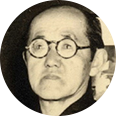Artwork of Hasui Kawase artprints & posters
A key painter of the late 19th and early 20th centuries, Hasui Kawase revitalized Japanese printmaking with a style directly influenced by the European Impressionists. Following in the footsteps of his predecessors, Hasui Kawase used printmaking to portray Japan at its best, with the difference that he favored the atmosphere of the image over the subject itself. Although little-known to the general public, his style is now part of modern Japonism, as "Japan culture" has spread around the world.
Discover the finest prints by Hasui Kawase, the major Japanese draughtsman and painter in the history of art in the late 19th and early 20th centuries, with his print "Snow at the Shinobazu Benten Shrine", one of many depicting the snowy landscapes of Japan, the print "Evening Glow in Spring, Temple Toshogu in Ueno", demonstrating his technique for retranscribing the multiple moods offered by the moon, or "Snow at Shin Bridge, Nikko", one of the representations of this bridge with "Shin Bridge, Nikko (Nikko Shinkyo)" presenting it in a totally different mood.
Treat yourself to a reproduction of a print worthy of the finest Japanese landscape photography available in Hasui Kawase's catalog, and discover the biography of one of the great artists of the Shin-hanga movement.
Biography of Hasui Kawase
Perseverance at the heart of Hasui Kawase's training
Born into a family of silk merchants, Hasui Kawase was born in 1883 in the Shiba district of Tokyo. After a stay with his aunt, due to his frail health, he developed a passion for drawing, and in particular for the Japanese landscapes that lay before him. So, at the age of 14, he took drawing lessons for 2 years. However, his family did not take kindly to Hasui Kawase's desire to become a draughtsman and enter the world of Japanese painting. He therefore had to wait until 1908, when the family business was taken over by another family member, before he could fully embark on this path. However, during this period, he did not forget his desire to pursue an artistic career, and continued to train in landscape drawing, as well as in Western art with watercolor and oil on canvas, as the canvases of Western painters using depth effects, and the influence of the West, had been increasingly present in Japan since the end of the 19th century and the beginning of the Meïji era.
At the age of 25, he first applied to join the studio of Kiyokata Kaburagi, one of the masters of Japanese printmaking at the time. After an initial setback, due to his age, and two years of hard training in woodcut techniques and Western oil painting, Kaburagi accepted Hasui Kawase's talent and took him on as a pupil. Surrounded by his master and other artists, Hasui Kawase developed his technique, drawing on each other's styles to extract only the best, and moved on to xylography, a technique for creating woodcut images, printed in relief on the wooden board, and used to make Japanese prints.
Watanabe and Hasui Kawase: a fruitful partnership
Thanks to his apprenticeship and impeccable technique, Hasui Kawase began working on illustrations and a whole series of woodcuts for the textile industry, advertising and illustrated magazines. However, he was soon introduced by his master to the most prominent print publisher of the early 20th century, Shozaburo Watanabe, who allowed him to open a new page in his life and practice his art in his preferred field: landscapes. This collaboration, which began in 1918, was to last a lifetime for both men.
The art of travel became indispensable for Hasui Kawase. He traveled throughout the provinces of the Land of the Rising Sun, creating etchings of Japanese landscapes and scenes of Japanese life and culture, in reproductions of unparalleled finesse at the time. From his sketches, Hasui Kawase developed an almost photographic technique, and with Watanabe's help, the Japanese painter and printmaker's career took off. During this period, he also painted a number of portraits around 1920, inspired by his uncle, then a creator and author of kabuki plays, one of the major cultural domains of Asian art.
Until 1923, Kawase delivered no fewer than 96 prints to Watanabe, most of which were published and exported internationally. However, an earthquake devastated Japan that same year, and the vast majority of Hasui Kawase's woodcuts were destroyed along with her studio. As the drawings could no longer be printed, and it was impossible to re-engrave a reproduction of these works without the original prints and sketches, except for a limited number of copies, Hasui Kawase started from scratch and embarked on a journey offered by Watanabe in 1924, from which a whole series of landscapes emerged. Watanabe's perfectionist influence on the final result of each print was also a factor in Hasui Kawase's success throughout her career.
Hasui Kawase: a recognized artist
1930 marked the beginning of a golden age for Hasui Kawase. The Japanese painter had enjoyed great success in his homeland, but his fame had even spread beyond the Far East, notably with two exhibitions devoted to him in 1930 and 1936 in the United States, at the Toledo Museum of Art. As with the Japanese art of his contemporaries and predecessors, the Japanese influence was exported to the United States and Europe, and gave rise to the Japonisme movement in vogue in artistic circles at the time, notably among post-Impressionists and Art Nouveau artists.
At home, Hasui Kawase continued to produce a large number of paintings and prints, and despite the war period which curtailed her production for several years, the government used prints by the artist to promote Japan's image and Japanese inspiration internationally. Her work became renowned among Japanese printmakers and print painters, and at the end of her life, the original print "Zojoji Temple in the Snow" was even awarded the "National Treasure" prize, the highest possible national distinction in the cultural world.
Hasui Kawase died in 1957, and even today, although her name isn't well known to the general public, collectors are still snapping up her old prints, whose original prices can reach record heights. On the Internet, too, "Japanese culture" makes it possible to find Hasui Kawase's work in digital prints, and his drawings regularly illustrate a Japanese culture that is expanding worldwide.
Hasui Kawase: the master of Shin-Hanga
Today, Hasui Kawase's prints are considered major works of Japanese painting, and more specifically of the Shin-Hanga movement. This movement, which has its origins in Ukiyo-e (translatable as "floating world"), leaves the artist to devote himself entirely to his art, leaving the other stages of the craft to the engraver, printer and publisher, who each act independently of the others. At the beginning of the 20th century, the reputation of ukiyo-e, which featured a variety of subjects, from landscapes such as Mount Fuji for Hokusai, to portraits, figures in action, women and eroticism, was exhausted, Shin-hanga, on the other hand, is inspired by the great European impressionist masters, with depth and play of light, leaving the landscape and culture of the country in the background, while the atmosphere of the image comes to the fore.
This is how Hasui Kawase came to use a palette of pigments, inks, tints and strokes that give her canvases a truly poetic dimension, beyond the subject itself. We find her precision in transcribing the atmosphere of a landscape, which almost gives the impression of dealing with photographs, with landscapes under snow as in "Spring snow at Kiyomizu Temple, Kyoto", in the night with "Spring Night in Inokashira", in the rain with "Rainy Night in Maekawa", or with the water of a lake or river, with "Full Moon on the Arakawa River" or "Lake Chûzenji in Nikko", among others. In this way, he is able to transcribe every ray of sunlight or the luminosity of the moon, and the movement of the elements through vegetation, a river, a lake or buildings.
Hasui Kawase was a pioneer in this style, mastering this very special technique and remaining very popular in Japan until the end of the 50's. He was considered one of the masters in this field, and today, whether in the form of digital prints, prints or reproductions of paintings, we can still see this Shin-hanga style, with "Japan culture" more in vogue than ever.
Learn more about the life and the works of Hasui Kawase.






























































































![Cloudy Day at Matsue in Izumo Province (Izumo Matsue [kumoribi]), from the series](https://en.muzeo.com/sites/default/files/styles/image_oeuvre_search/public/oeuvres/posters/modern/cloudy_day_at_matsue_in_izumo_229045.jpg?itok=mpatHOMr)

















































